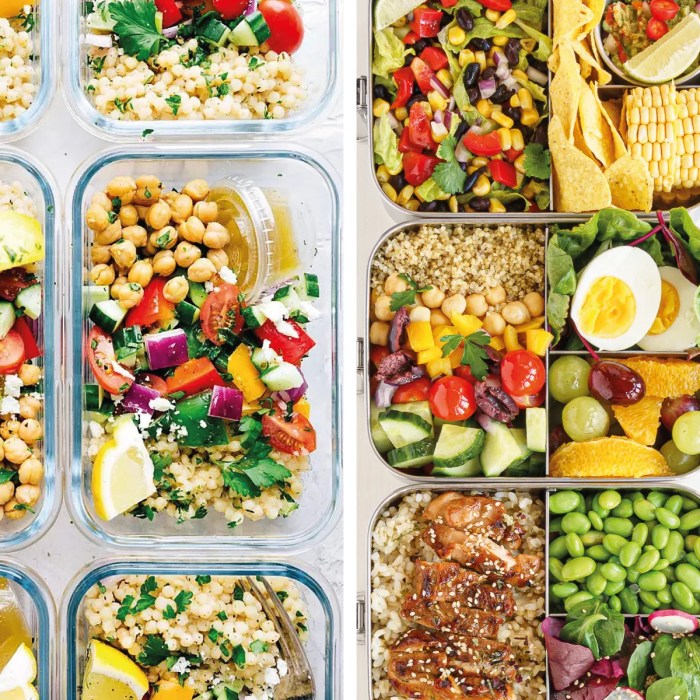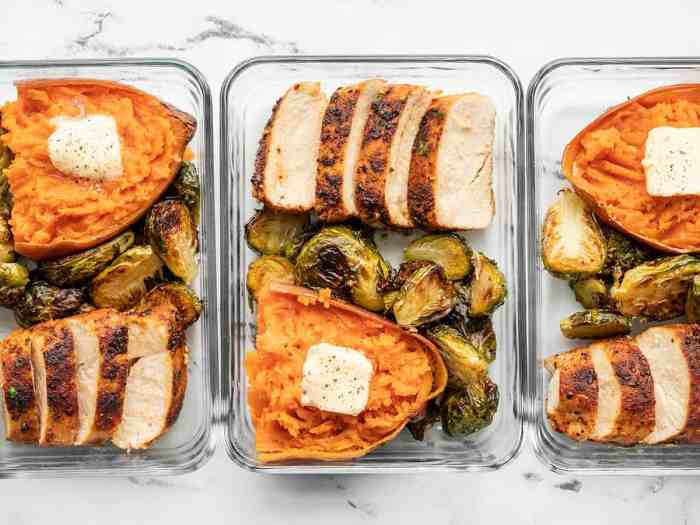Meal Prep Ideas: Get ready to elevate your meal game with these awesome tips and tricks that will make your life easier and tastier. From saving time and money to creating delicious and nutritious meals, this guide has got you covered.
Are you ready to dive into the world of meal prepping like a boss? Let’s get started!
Benefits of Meal Prep Ideas

Meal prepping is a game-changer when it comes to saving time, money, and ensuring you have nutritious meals ready to go at all times. Let’s dive into the advantages of incorporating meal prep ideas into your routine.
Save Time and Money
Meal prepping allows you to plan your meals in advance, which means less time spent in the kitchen every day. By cooking in bulk and portioning out meals for the week, you can also save money by buying ingredients in larger quantities and avoiding last-minute takeout or dining out expenses.
Ready-to-Eat Meals, Meal Prep Ideas
Having meals prepped and ready to eat in your fridge or freezer means you can grab a nutritious option quickly, especially during busy weekdays or when you’re too tired to cook. This can help you stick to your health goals and avoid unhealthy food choices when you’re feeling rushed or stressed.
Meal Prep Containers
When it comes to meal prepping, choosing the right containers is crucial to keep your food fresh and organized throughout the week. There are various types of meal prep containers available in the market, but the most common options are glass and plastic containers.
Glass Containers
Glass containers are durable, eco-friendly, and do not retain odors or stains. They are microwave and dishwasher safe, making them convenient for reheating meals. However, glass containers can be heavier and more fragile than plastic ones, posing a risk of breakage if not handled carefully.
Plastic Containers
Plastic containers are lightweight, shatterproof, and more affordable than glass containers. They come in a variety of shapes and sizes, making them versatile for different types of meals. However, some plastic containers may contain harmful chemicals like BPA, which can leach into food, especially when heated.
Tips for Choosing the Right Containers
- Consider the material: Choose glass containers for durability and safety, or opt for BPA-free plastic containers if convenience and affordability are your priorities.
- Size matters: Select containers with compartments or multiple sizes to accommodate different portions of food.
- Airtight lids: Look for containers with secure seals to prevent leaks and keep your meals fresh longer.
- Stackable design: Choose containers that can be easily stacked to save space in your fridge or pantry.
- Ease of cleaning: Make sure the containers are dishwasher safe for easy cleaning and maintenance.
Healthy Meal Prep Ideas

When it comes to meal prepping, incorporating healthy options is key to maintaining a balanced diet and achieving your wellness goals. By preparing nutritious meals in advance, you can save time and ensure you have access to wholesome food throughout the week.
Examples of Balanced Meal Prep Recipes
- Grilled chicken with quinoa and roasted vegetables
- Salmon with brown rice and steamed broccoli
- Turkey chili with sweet potatoes and green beans
- Veggie stir-fry with tofu and brown rice
- Greek salad with grilled shrimp and whole wheat pita
Tips for Incorporating More Fruits and Vegetables
Adding fruits and vegetables to your meal prep is a great way to boost your nutrient intake and add variety to your meals. Here are some tips:
- Choose a variety of colorful fruits and vegetables to ensure you get a range of vitamins and minerals.
- Prep fruits and veggies in advance by washing, chopping, and portioning them for easy access throughout the week.
- Incorporate fruits into breakfast options like smoothie bowls or overnight oats, and add veggies to lunch and dinner recipes like salads, stir-fries, and soups.
- Experiment with different cooking methods like roasting, steaming, and sautéing to keep things interesting.
The Importance of Portion Control
Proper portion control is essential when meal prepping to ensure you are consuming the right amount of nutrients without overeating. Here are some tips:
- Use measuring cups or a food scale to portion out proteins, grains, and veggies to avoid overfilling containers.
- Consider using smaller containers to help control portion sizes and prevent mindless eating.
- Aim to fill half of your plate with vegetables, one-quarter with lean protein, and one-quarter with whole grains for a balanced meal.
- Listen to your body’s hunger cues and stop eating when you feel satisfied, rather than finishing everything on your plate.
Meal Prep Tips for Beginners: Meal Prep Ideas
Starting meal prepping can seem overwhelming, but with the right tips and tools, it can become a seamless part of your routine. Here are some tips for beginners to help you get started on your meal prep journey.
Essential Kitchen Tools for Meal Prep
When it comes to meal prepping, having the right tools can make a world of difference. Here are some essential kitchen tools that every beginner meal prepper should have:
- Quality knives and cutting boards: Invest in a good set of knives and cutting boards to make chopping vegetables and proteins a breeze.
- Meal prep containers: Stock up on a variety of meal prep containers in different sizes to store your prepped meals conveniently.
- Storage bags and wraps: Have a supply of storage bags, plastic wraps, and foil to keep your ingredients fresh and organized.
- Meal prep trays or sheet pans: Use meal prep trays or sheet pans to cook large batches of food at once, saving time and energy.
Staying Organized During Meal Prep Sessions
Organization is key when it comes to successful meal prepping. Here are some strategies to help you stay organized during your meal prep sessions:
- Plan your meals in advance: Take some time to plan your meals for the week, including recipes and ingredients needed.
- Use a meal prep schedule: Create a meal prep schedule to allocate specific days and times for planning, shopping, prepping, and cooking.
- Prep ingredients in batches: Streamline your meal prep process by prepping ingredients in batches, such as chopping vegetables or marinating proteins all at once.
- Clean as you go: Keep your workspace clean and organized by washing dishes, utensils, and countertops as you work to avoid a big mess at the end.
Meal Prep for Weight Loss
Meal prepping can be a game-changer when it comes to achieving weight loss goals. By planning and preparing your meals in advance, you can control portion sizes, make healthier choices, and avoid the temptation of fast food or unhealthy snacks.
Low-Calorie Meal Prep Recipes
- Baked chicken breast with roasted vegetables
- Quinoa salad with mixed greens and grilled shrimp
- Turkey chili with black beans and bell peppers
- Veggie stir-fry with tofu and brown rice
Creating a Meal Plan for Weight Loss
- Start by calculating your daily calorie needs and set a realistic weight loss goal.
- Choose a variety of nutrient-dense foods like lean proteins, whole grains, fruits, and vegetables.
- Plan your meals and snacks for the week, including breakfast, lunch, dinner, and healthy snacks.
- Prep your ingredients in advance, portion out your meals, and store them in meal prep containers for easy access.
- Stay consistent with your meal plan and make adjustments as needed based on your progress.